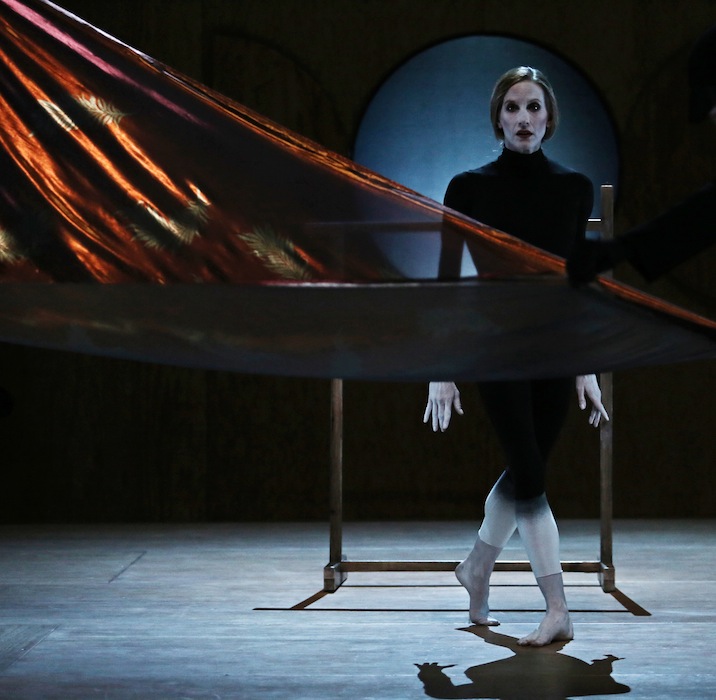“Hagoromo” offers moments of beauty amid words of banality
The divide and the distance between heaven and earth is the subject of Hagoromo, a music theater work that premiered Tuesday night in the BAM Harvey Theater, part of the current Next Wave festival. The story comes from a traditional Noh play, in which an angel loses her cloak, which falls to the earth and is recovered by a fisherman. Without it, she cannot fly, and at first the fisherman is reluctant to return such an extraordinary object. But when she dances for him, he feels ashamed, and gladly relinquishes the cloak.
This production is described as a chamber opera, but it is far more than that. It’s a multimedia work that eschews the commonplace of video. Everything is live: music, dance, singing, narration, and puppetry. When all the elements are working at the same, high level, Hagoromo is magic, but there are also prosaic details and stretches that keep it earth-bound.
The fine score is by composer Nathan Davis, played by members of ICE and sung by mezzo-soprano Katalin Károlyí and tenor Peter Tantsits, along with girls of the Brooklyn Youth Chorus. All the musicians were led with assured clarity by conductor Nicholas DeMaison.
Károlyí and Tantsits sing the roles of the Angel and Fisherman (including third person narration of each character’s experience), but they don’t act out the roles on stage. Dancers Wendy Whelan and Jock Soto, former principals at the New York City Ballet, tell the tale through movement, and Whelan is also accompanied by Chris Green’s puppets, two of which are life size (each manipulated by three puppeteers) and are made to look like Whelan herself.
Davis’s music and David Neumann’s choreography are complementary, exploring different parts of the story in parallel, and the experience is rich. The score is lyrically evocative and pointillist, with timbres that allude to Japanese music, and with few straight rhythms—it is the dancers who lay out the rhythmic patterns. The drama follows a linear narrative, but the closeness to ballet means the storytelling is also a display of abstract beauty. At its finest, Hagoromo is stunningly beautiful.
This is most prominently so at the beginning. With the stage in half-light, and Whelan made up in ghostly white makeup and wearing a black body suit, the dancing seems supernatural. The pace of Whelan’s movements are slow, Noh-like, and there are wonderful little baroque dance steps. The effect of the lighting (designed by Clifton Taylor) highlights various extensions of hand or foot that seem different than what the human body can do. Whelan’s stage affect is itself mysterious and otherwordly.
The music enhances this to heights of sensual intensity. At the start, and throughout the piece, there are long stretches of ad lib playing, with percussion and flute prominent. Flutist Claire Chase primarily played the bass and contrabass flutes, and her sound on the latter instrument was full, with an erotic quality.
But there are stretches of ordinariness that are out of place in the larger experience. The culprits are Brendan Pelsue’s libretto and the overall direction by artist David Michalek—Whelan’s husband—who conceived the piece.
Amidst the visual and musical poetry, the libretto is obvious. When the dance and the music are so eloquently clear hearing lines like “She is a flower weeping/She is a small bird wilting” was jarring, each literal line of pandering broke the spell the performers were creating.
Whelan and Soto are famous for their dramatic partnership, but there’s strangely nothing for them to do together. They speak to each other in dance, but never with each other: the angel asks for the cloak, the fisherman refuses, she needs it to fly again, the fisherman asks her to dance, she dances, all in turn.
The scenes in heaven are subtly but clearly set in the context of Japanese visual art—the cloak itself is lost through the genre image of a cat and a dog (puppets again) playing together—while those on Earth are colorless. The charm of heaven vis-a-vis the blandness of earthly existence is an idea, but what that meant on stage was a discomfiting contrast between being amazed and being bored.
This was shadowed by the sound production—all the musicians are amplified, and while Jody Elff’s sound design was mostly transparent, Tantsits and bassoonist Rebekah Heller were distorted, the important upper partials of their instruments cropped out.
Even with the problematic details, this is a tidy ninety-minute show that moves steadily at a pleasing Andante pace. The powerful spectacle of the opening scene along is worth the price of admission, and the return to heaven brings everything back to where we want it to be.
Hagoromo continues through November 7. bam.org
